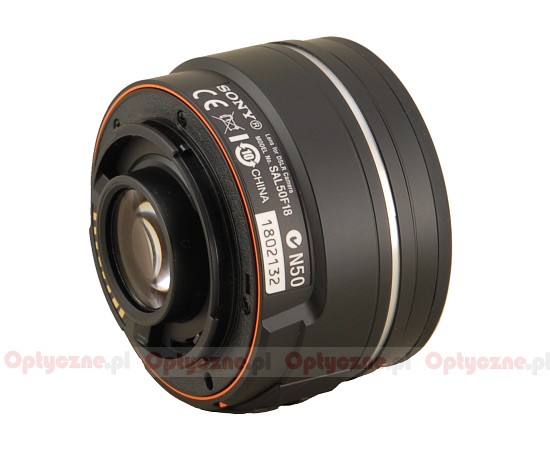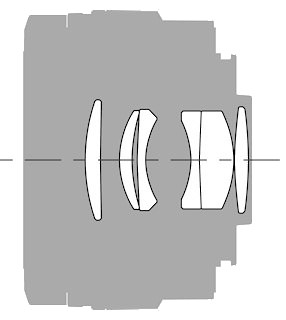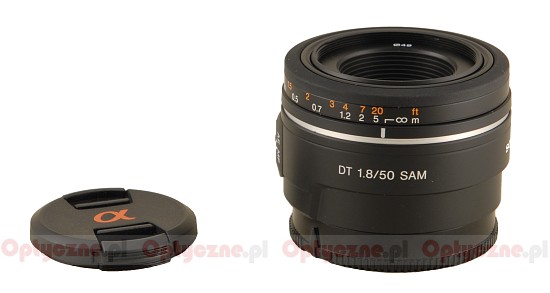Sony DT 50 mm f/1.8 SAM
3. Build quality
 |
What’s interesting, the lens appears to be the largest in the field. It’s more comparable to Canon, slightly bigger than Nikkor and, what’s more, noticeable bigger than the full-frame Sony 1.4/50 with better light-gathering power. Larger dimensions are partly the effect of a built-in SAM motor. Non-accidentally the smallest in the field are the lenses without the motor, i.e. Nikkor and Sony 1.4/50.
Please Support UsIf you enjoy our reviews and articles, and you want us to continue our work please, support our website by donating through PayPal. The funds are going to be used for paying our editorial team, renting servers, and equipping our testing studio; only that way we will be able to continue providing you interesting content for free. |
- - - - - - - - - - - - - - - - - - - - - - - - - - - - - - - - - - - - - - - - - - - - - - - -
Full comparison of the new Sony lens and its rivals is presented in the following table. From it we can see that DT 50mm f/1.8 SAM is very similar to other lenses in its class. It gives us more than its rivals do, though. In its case the minimum distance from which an image is sharp equals 34 cm, while in the competitors’ it is 45cm.
Let’s discuss the build of the lens now. In this price class you economize on everything, so it’s nothing strange that we have to deal with all-embracing plastic. The whole body, including the bayonet, is made of plastic. It’s not different with Canon 1.8/50 II and only Nikkor 1.8/50 surprises us giving a metal bayonet.
 |
Behind the plastic bayonet we find smooth body with the name of the lens and on the left side an AF/MF switch. Farther we find thin, silver ring giving the lens some charm, and a ring for manual focusing, on which there’s a distance scale expressed in feet and meters. The ring is not ribbed and too loose for our taste, so operating it doesn’t allow finessed moves. A similar situation occurred with Nikkor, and Canon performs the worst here, having practically useless focusing ring with no distance scale at all.
Focusing makes all the elements inside move together, without changing their reciprocal position. Additionally, it doesn’t force the front element of 49mm diameter to rotate, allowing trouble-free work with all kinds of filters.
As far as the optical construction is concerned, we have 6 elements in 5 groups. The exact same numbers we find in Canon and Nikkor, and in Minolta 1.7/50. Inside the lens there are also 7 diaphragm blades to form the minimal aperture of f/22. And, to be exact, not f/22 but somewhere around f/19. To become convinced it’s enough to take one picture with f/16 at a given exposure time, and then set to f/22 and take another picture with twice the exposure time, to find that it’s brighter than the one of f/16 aperture. In addition, higher MTF50 value in resolution test proves this effect as well, being simply too high for f/22. Fortunately, taking pictures with f/16-22 aperture is rare enough not to bother your mind with this fact.

As we said earlier, in this price class you economize on everything, so it’s not surprising that we only get both caps in the set.
 |






